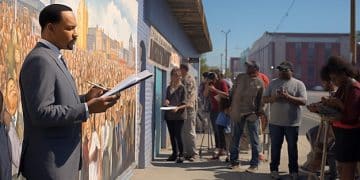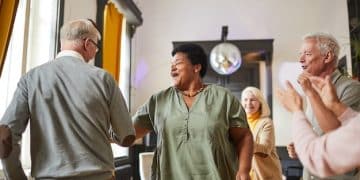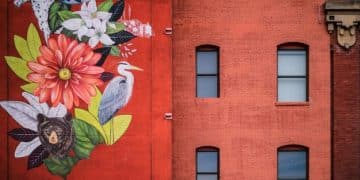Preserving Cultural Heritage: Documenting Local Art Traditions in the US
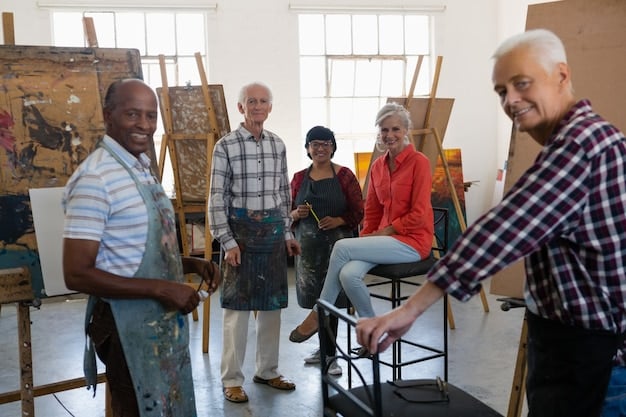
Preserving cultural heritage involves documenting local art traditions to ensure their survival and continuity for future generations, encompassing various forms of art, crafts, music, and storytelling unique to communities within the United States.
Preserving cultural heritage: a guide to documenting local art traditions is crucial for maintaining community identity and historical memory. This guide provides insights into methods and strategies that ensure these unique expressions are not lost but celebrated and passed on. Let’s explore how you can contribute to keeping these traditions alive.
Understanding the Importance of Cultural Heritage Preservation
Cultural heritage preservation isn’t just about keeping old things around; it’s about maintaining a connection to the past that enriches the present and informs the future. Local art traditions are a vital part of this heritage.
These traditions tell stories, embody values, and represent the unique experiences of communities. By understanding their significance, we can better appreciate the need to preserve them.
Why Local Art Traditions Matter
Local art traditions often reflect the distinct environments, historical events, and social structures of their originating communities. Preserving them ensures that these unique aspects of local culture are not forgotten.
- Telling Unique Stories: Art traditions are powerful storytellers, keeping alive the narratives of past generations.
- Maintaining Community Identity: These traditions help define what makes a community unique, fostering a sense of belonging and pride.
- Passing on Skills and Knowledge: Preservation efforts often involve teaching these art forms to younger generations, ensuring the continuation of cultural practices.
Ignoring these traditions leads to cultural homogenization, where distinct local identities are diluted or lost. Documenting and preserving them is a way to counteract this trend.
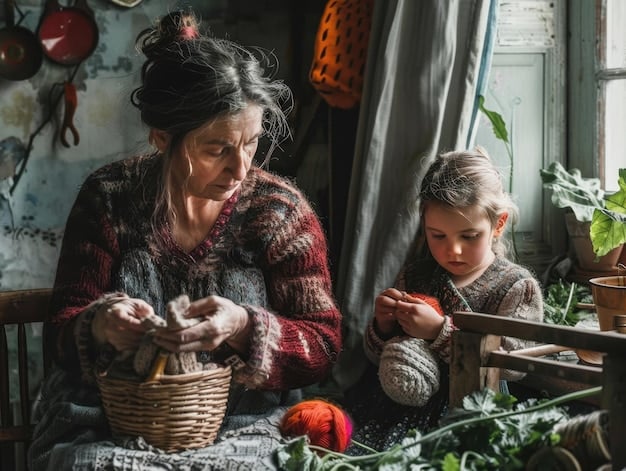
Methods for Documenting Local Art Traditions
Documenting local art traditions involves a variety of techniques, each with its own strengths and challenges. Selecting the right methods depends on the type of tradition, the resources available, and the community’s preferences.
From written records to visual and audio documentation, there are many ways to capture the essence of these traditions.
Written Documentation
Creating written records is a fundamental aspect of documenting art traditions. This can include detailed descriptions of the art form, its history, and its significance.
Interviews with artists and community members provide valuable insights that can be recorded in written form. These accounts capture personal experiences and perspectives.
- Historical Accounts: Researching and documenting the history of the art tradition helps contextualize its significance.
- Artist Interviews: Conducting interviews with artists offers firsthand accounts of their techniques, inspirations, and challenges.
- Community Stories: Gathering stories from community members provides a broader perspective on the role of the art tradition in their lives.
Ensure that all written documentation is properly archived and accessible to future generations.
Utilizing Visual Documentation Techniques
Visual documentation techniques, such as photography and videography, are invaluable for capturing the aesthetic and practical aspects of local art traditions. They provide a visual record that complements written documentation.
High-quality images and videos can capture the nuances of the art form, from the texture of materials to the movements of the artist.
Photography
Photography is a powerful tool for documenting art traditions. Detailed photographs can showcase the artistry, techniques, and cultural context of the art form.
Photographs can also document the artists at work, providing a glimpse into their creative process.
- Detail Shots: Capturing close-up shots of the artwork reveals intricate details that might otherwise be missed.
- Artist Portraits: Taking portraits of the artists within their environment adds a personal touch to the documentation.
- Contextual Photos: Including images that show the art tradition within its cultural context helps tell a more complete story.
Ensure that all photographs are properly labeled and archived, with clear descriptions of the subject, date, and location.
Incorporating Audio Documentation
Audio documentation captures the sounds associated with local art traditions, providing a rich auditory experience that complements visual and written records. This is particularly important for traditions that involve music, storytelling, or spoken word.
Recordings can preserve not only the sounds themselves but also the nuances of language and expression.
Oral Histories
Collecting oral histories is a key aspect of audio documentation. These recordings capture the personal experiences and perspectives of artists and community members.
Oral histories can provide valuable insights into the history, techniques, and cultural significance of the art tradition.
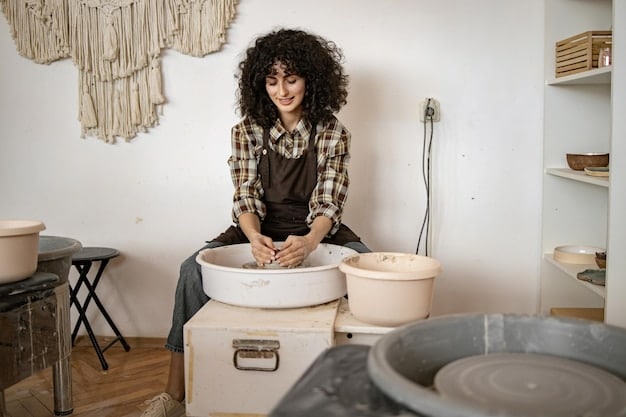
- Capturing Stories: Recording stories about the art tradition preserves cultural narratives and personal memories.
- Documenting Techniques: Audio recordings can describe the sounds of specific techniques or processes.
- Preserving Language: Oral histories can help preserve endangered languages or dialects associated with the art tradition.
Ensure that all audio recordings are properly labeled and archived, with clear descriptions of the speakers, date, and location.
Community Collaboration and Ethical Considerations
Preserving cultural heritage requires a collaborative approach that respects the rights and perspectives of the community. Ethical considerations are paramount to ensure that documentation efforts are conducted responsibly.
Engaging with the community from the outset helps build trust and ensures that the documentation accurately reflects their values and beliefs.
Obtaining Informed Consent
Informed consent is essential when documenting local art traditions. This means obtaining permission from artists and community members before recording their stories, images, or performances.
Explain the purpose of the documentation, how it will be used, and who will have access to it. Ensure that participants understand their rights and can withdraw their consent at any time.
- Clear Communication: Use clear and accessible language to explain the documentation process.
- Respect for Privacy: Be mindful of individuals’ privacy and avoid documenting sensitive information without their explicit consent.
- Shared Ownership: Consider sharing ownership of the documentation with the community, allowing them to control how it is used and shared.
Establish clear protocols for data storage, access, and usage to protect the interests of the community.
Creating Accessible Archives and Digital Preservation
Creating accessible archives is crucial for ensuring that documented art traditions are available to future generations. Digital preservation techniques play a key role in this process.
Digital archives can be easily searched, accessed, and shared, making them an invaluable resource for researchers, artists, and community members.
Digital Archiving Strategies
Digital archiving involves creating and maintaining digital copies of documented materials. This includes photographs, videos, audio recordings, and written records.
Digital archives can be stored on local servers, cloud-based platforms, or a combination of both. Regular backups are essential to prevent data loss.
- File Formats: Use standard file formats that are widely supported and likely to remain accessible in the future.
- Metadata: Add metadata to each file, including descriptions, dates, locations, and the names of individuals involved.
- Accessibility: Design the digital archive to be accessible to users with disabilities, following accessibility guidelines.
Establish clear policies for data management, security, and long-term preservation.
Sharing and Promoting Documented Art Traditions
Sharing and promoting documented art traditions is essential for raising awareness and fostering appreciation for local cultural heritage. This can be achieved through a variety of channels, including exhibitions, publications, and online platforms.
By showcasing these traditions, we can inspire others to learn about and support them, ensuring their continued survival and vitality.
Engaging with New Generations
Engaging new generations is crucial for ensuring the long-term survival of local art traditions. This can involve educational programs, workshops, and community events.
By involving young people in the documentation and preservation process, we can cultivate a sense of ownership and pride in their cultural heritage.
- Educational Programs: Integrate local art traditions into school curricula to educate students about their cultural heritage.
- Community Workshops: Organize workshops where artists can share their skills and knowledge with community members.
- Online Platforms: Create online platforms where young people can share their own art and stories, fostering a sense of community and creativity.
By actively involving new generations, we can ensure that local art traditions continue to thrive and evolve.
| Key Point | Brief Description |
|---|---|
| 📸 Visual Documentation | Use photography and videography to capture art techniques and aesthetics. |
| ✍️ Written Records | Document history, artist interviews, and community stories in written form. |
| 🗣️ Community Collaboration | Engage the community and obtain informed consent for documentation. |
| 💾 Digital Archives | Create accessible digital archives for long-term preservation and sharing. |
Frequently Asked Questions
▼
Preserving cultural heritage maintains community identity, ensures continuity for future generations, and honors the unique stories and values of local art traditions.
▼
Effective methods include written documentation, visual documentation (photography and videography), audio recordings (oral histories), and community collaboration to ensure accuracy.
▼
Communities can participate by sharing stories, offering insights, providing historical context, and actively engaging in the documentation and promotion of their art traditions.
▼
Key ethical considerations include obtaining informed consent, respecting privacy, acknowledging cultural sensitivities, and ensuring shared ownership of the documented materials and stories.
▼
Digital archives ensure long-term accessibility, enable easy sharing, facilitate broader engagement, and provide a secure repository for photos, videos, oral histories, and written records.
Conclusion
Preserving local art traditions is a collaborative endeavor that enriches communities and ensures the continuity of cultural heritage. By employing thorough documentation methods, respecting ethical considerations, and fostering community engagement, we can safeguard these traditions for future generations, celebrating the unique expressions that define us.
